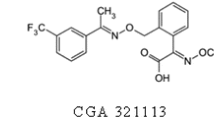Abstract
This research aims at determining residues of thiophanate methyl and propiconazole in grape and mango fruits as an indication for their persistence in this environmental compartment. Fruit extracts were analyzed for thiophanate methyl using High Performance Liquid Chromatography and using Gas Chromatography Electron Capture Detector (GC/ECD), respectively. The results indicated that propiconazole had a less environmental impact since propiconazole had shorter residue half-lives which were 1.24 and 1.19 days in grape and mango fruits, respectively, while thiophanate methyl had half-lives of 2.49 and 2.64 days in mango and grape, respectively. The degradation rates of propiconazole in grape and mango fruits did not change significantly and neither did those of thiophanate methyl. According to the maximum residue level, the pre-harvest intervals of propiconazole were set to be 3 and 7 days for grape and mango fruits, respectively, and the pre-harvest intervals for thiophanate methyl were 15 days for both grape and mango fruits. Propiconazole was generally considered to be less hazardous to humans and will leave the environment less altered because of its faster degradation than that of thiophanate methyl.

Similar content being viewed by others
References
Alam S, Kole RK, Bhattacharyya A (2011) Residual fate of the fungicide tetraconazole (4% EW) in mango. Bull Environ Contam Toxicol 87:444–447. doi:10.1007/s00128-011-0362-4
Anastassiades M, Lehotaym SJ, Stajnbaher D, Schenck FJ (2003) Fast and easy multiresidue method employing acetonitrile extraction/partitioning and “dispersive solid-phase extraction” for the determination of pesticide residues in produce. J AOAC Int 86:412–431
Barakat DA, Nasr IN,, El-Mahy SA, El-Hefny DE (2006) Persistence of the fungicides tetraconazole and penconazole residues on and some vegetables grown in the green house and under environmental conditions. Bull Fac Agric Univ Cairo 57:511–529
EU (2010) MRL, Environmental Protection Agency. Reregistration Eligibility Decision:Propiconazole.(July2006) Accessed 16 Sept 2010
FAO (2013) Food and Agriculture Organization of the United Nations, Statistics division, http://faostat3.fao.org/browse/Q/QC/E
Goulson D, Nicholls E, Botías C, Rotheray EL (2015) Bee declines driven by combined stress from parasites, pesticides, and lack of flowers. Science. doi:10.1126/science.1255957
Hayes T, Khoury V, Narayan A, Nazir M, Park A, Brown T, Adame L, Chan E, Buchholz D, Stueve T, Gallipeau S (2010) Atrazine induces complete feminization and chemical castration in male African clawed frogs (Xenopus laevis). PNAS 107:4612–4617. doi:10.1073/pnas.0909519107
Hjorth K, Johansen K, Holen B, Andersson A, Christensen HB, Siivinen K, Toome M (2011) Pesticide residues in fruits and vegetables from South America, a nordic project. Food Control 22:1701–1706. doi:10.1016/j.foodcont.2010.05.017
Hou Z, Wang X, Zhao X, Wang X, Yuan X, Lu Z (2016) Dissipation rates and residues of fungicide azoxystrobin in ginseng and soil at two different cultivated regions in china. Environ Monit Assess 188:440. doi:10.1007/s10661-016-5449-2
Janaki P, Priya RS, Chinnusamy C (2013) Field dissipation of oxyfluorfen in onion and its dynamics in soil under Indian tropical conditions. J Environ Sci Health B 48:941–947. doi:10.1080/03601234.2013.816599
Mahmoud HA, Arief MMH, Nasr IN, Mohammed IH (2010). Residues and half-lives of abamectin, diniconazole and methomyl on and in strawberry under the normal field conditions. Appl Sci Res 6:932–936
Malhat F, Abdallah H, Hegazy I (2012) Dissipation of chlorantraniliprole in tomato fruits and soil. Bull Environ Contam Toxicol 88:349–351
Malhat F, Badawy H, Barakat D, Saber A (2014) Residues, dissipation and safety evaluation of chromafenozide in strawberry under open field conditions. Food Chem 152:18–22
Mandal S, Das S, Bhattecharyya A (2010) Dissipation study of thiophanate methyl residue in/on grapes (Vitis vinifera L.) in India. Bull Environ Contam Toxicol 84:592–595. doi:10.1007/s00128-010-9985-0
Mariyono J (2008) Direct and indirect impacts of integrated pest management on pesticide use: a case of rice agriculture in Java, Indonesia. Pest Manag Sci 64:1069–1073. doi:10.1002/ps.1602
Mohapatra S (2015) Residue levels and dissipation behaviors for trifloxystrobin and tebuconazole in mango fruit and soil. Environ Monit Assess 187:95–105. doi:10.1007/s10661-015-4324-x
Moye HA, Malagodi MH, Yoh J, Leibee GL, Ku CC, Wislocki PG (1987) Residues of avermectin B1a: rotational crops and soils following soil treatment with (C14) avermectin B1a. J Agric Food Chem 35:859–864. doi:10.1021/jf00078a003
Romeh A, Mekky TM, Ramadan R, Hendawi M (2009) Dissipation of profenophos, imidacloprid and penconazole in tomato fruits and products. Bull Environ Contam Toxicol 83:812–817. doi:10.1007/s00128-009-9852-z
R-K Smith (1999) Handbook of environmental analysis 4th edn. Aoac International, Gaithersburg
SANCO/12495 2011 (2011). Method validation and quality control procedures for pesticide residues analysis in food and feed. EURL Joint Workshop, Germany
Sun C, Cang T, Wang Z, Wang X, Yu R, Wang Q, Zhao X (2015) Degradation of three fungicides following application on strawberry and a risk assessment of their toxicity under greenhouse conditions. Environ Monit Assess 187:303. doi:10.1007/s10661-015-4539-x
Tandon S (2016) Dissipation of pendimethalin in soybean crop under field conditions. Bull Environ Contam Toxicol 96:694–698. doi:10.1007/s00128-016-1764-0
Timme G, Frehse H (1980) Statistical interpretation and graphic representation of the degradation behaviour of pesticide residues.–Pflanzenschutz Nachrichten Bayer 33:47–60
Zhang Z, Jiang W, Jian Q, Song W, Zheng Z, Ke C, Liu X (2014) Thiabendazole uptake in Shimeji, king oyster, and oyster mushrooms and its persistence in sterile and nonsterile substrates. J Agric Food Chem 62:1221–1226. doi:10.1021/jf405208h
Author information
Authors and Affiliations
Corresponding author
Rights and permissions
About this article
Cite this article
Soliman, A.S., Helmy, R.M.A., Nasr, I.N. et al. Behavior of Thiophanate Methyl and Propiconazole in Grape and Mango Fruits Under the Egyptian Field Conditions. Bull Environ Contam Toxicol 98, 720–725 (2017). https://doi.org/10.1007/s00128-017-2066-x
Received:
Accepted:
Published:
Issue Date:
DOI: https://doi.org/10.1007/s00128-017-2066-x




